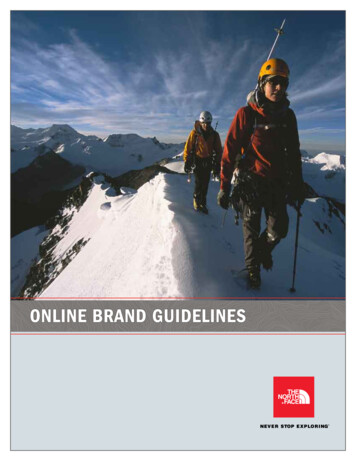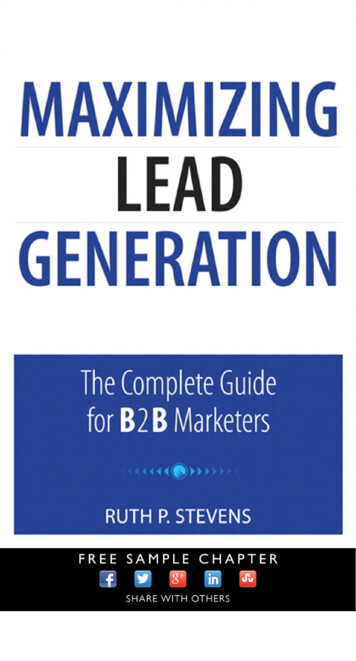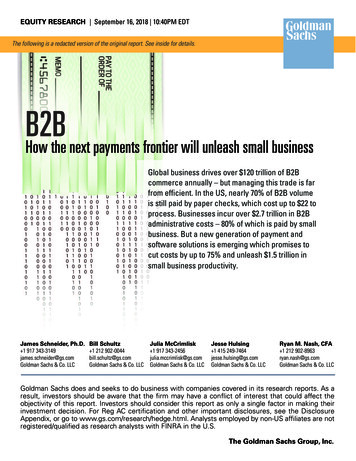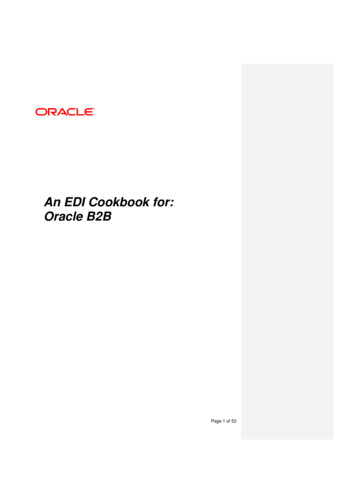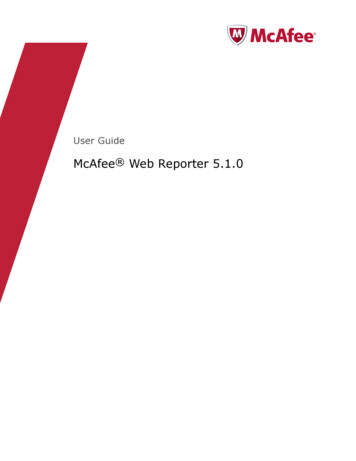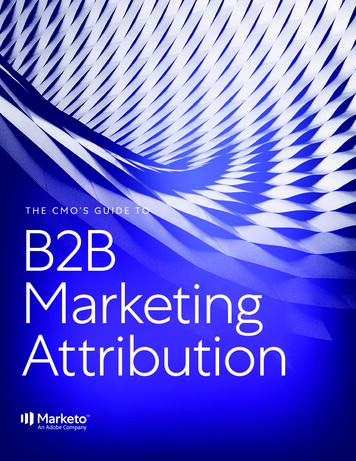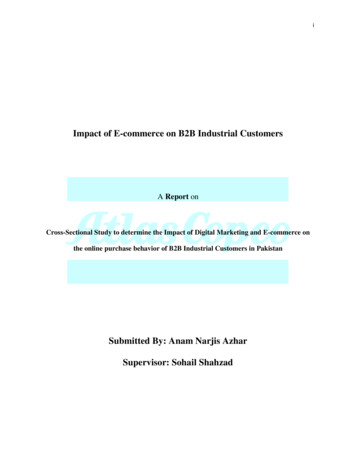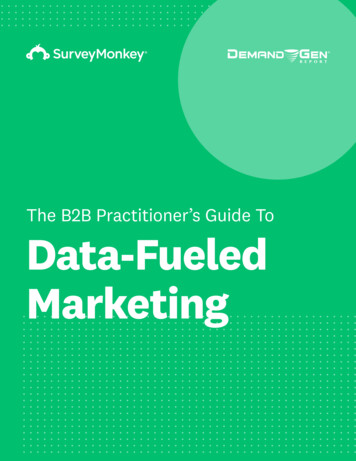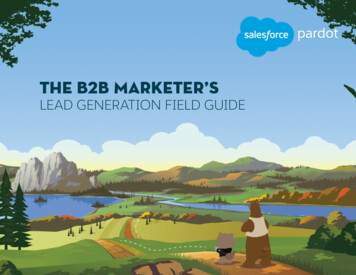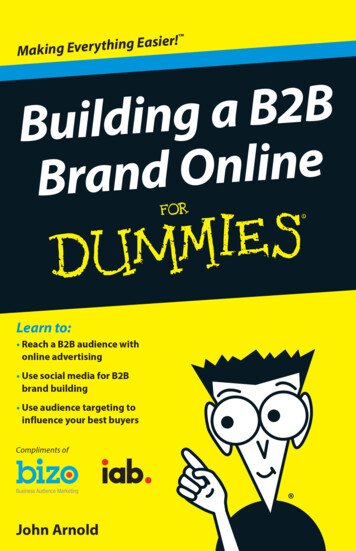
Transcription
Building a B2BBrand OnlineFORDUMmIES‰by John ArnoldThese materials are the copyright of John Wiley & Sons, Inc. and anydissemination, distribution, or unauthorized use is strictly prohibited.
Building a B2B Brand Online For Dummies Published byJohn Wiley & Sons, Inc.111 River StreetHoboken, NJ 07030-5774www.wiley.comCopyright 2013 by John Wiley & Sons, Inc., Indianapolis, IndianaPublished by John Wiley & Sons, Inc., Indianapolis, IndianaNo part of this publication may be reproduced, stored in a retrieval system or transmitted in anyform or by any means, electronic, mechanical, photocopying, recording, scanning or otherwise,except as permitted under Sections 107 or 108 of the 1976 United States Copyright Act, without theprior written permission of the Publisher. Requests to the Publisher for permission should beaddressed to the Permissions Department, John Wiley & Sons, Inc., 111 River Street, Hoboken, NJ07030, (201) 748-6011, fax (201) 748-6008, or online at http://www.wiley.com/go/permissions.Trademarks: Wiley, the Wiley logo, For Dummies, the Dummies Man logo, A Reference for the Restof Us!, The Dummies Way, Dummies.com, Making Everything Easier, and related trade dress aretrademarks or registered trademarks of John Wiley & Sons, Inc. and/or its affiliates in the UnitedStates and other countries, and may not be used without written permission. All other trademarksare the property of their respective owners. John Wiley & Sons, Inc., is not associated with any product or vendor mentioned in this book.LIMIT OF LIABILITY/DISCLAIMER OF WARRANTY: THE PUBLISHER AND THE AUTHORMAKE NO REPRESENTATIONS OR WARRANTIES WITH RESPECT TO THE ACCURACY OR COMPLETENESS OF THE CONTENTS OF THIS WORK AND SPECIFICALLY DISCLAIM ALL WARRANTIES, INCLUDING WITHOUT LIMITATION WARRANTIES OF FITNESS FOR A PARTICULARPURPOSE. NO WARRANTY MAY BE CREATED OR EXTENDED BY SALES OR PROMOTIONALMATERIALS. THE ADVICE AND STRATEGIES CONTAINED HEREIN MAY NOT BE SUITABLE FOREVERY SITUATION. THIS WORK IS SOLD WITH THE UNDERSTANDING THAT THE PUBLISHERIS NOT ENGAGED IN RENDERING LEGAL, ACCOUNTING, OR OTHER PROFESSIONAL SERVICES.IF PROFESSIONAL ASSISTANCE IS REQUIRED, THE SERVICES OF A COMPETENT PROFESSIONALPERSON SHOULD BE SOUGHT. NEITHER THE PUBLISHER NOR THE AUTHOR SHALL BE LIABLEFOR DAMAGES ARISING HEREFROM. THE FACT THAT AN ORGANIZATION OR WEBSITE ISREFERRED TO IN THIS WORK AS A CITATION AND/OR A POTENTIAL SOURCE OF FURTHERINFORMATION DOES NOT MEAN THAT THE AUTHOR OR THE PUBLISHER ENDORSES THEINFORMATION THE ORGANIZATION OR WEBSITE MAY PROVIDE OR RECOMMENDATIONS ITMAY MAKE. FURTHER, READERS SHOULD BE AWARE THAT INTERNET WEBSITES LISTED INTHIS WORK MAY HAVE CHANGED OR DISAPPEARED BETWEEN WHEN THIS WORK WAS WRITTEN AND WHEN IT IS READ.For general information on our other products and services, or how to create a custom For Dummiesbook for your business or organization, please contact our Business Development Department in theU.S. at 877-409-4177, contact info@dummies.biz, or visit www.wiley.com/go/custompub. Forinformation about licensing the For Dummies brand for products or services, contactBrandedRights&Licenses@Wiley.com.ISBN 978-1-118-48168-4 (pbk); ISBN 978-1-118-48229-2 (ebk)Manufactured in the United States of America10 9 8 7 6 5 4 3 2 1These materials are the copyright of John Wiley & Sons, Inc. and anydissemination, distribution, or unauthorized use is strictly prohibited.
Table of ContentsChapter 1: B2B Brand-Building Basics. . . . . . . . . . . . . . . 1About This Book. 1Icons Used in This Book. 2Understanding Why B2B Brand Building Matters. 2Reaching the B2B Audience . 4Advertising throughout the Marketing Funnel. 6Chapter 2: Placing B2B Targeted Display Ads. . . . . . . . . 9The Many Flavors of Targeted Display Advertising. 10Exploring Everything You Need to Know About Ad Creative.13Chapter 3: Retargeting for the B2B Audience . . . . . . . . 17The Basics of Retargeting. 18Setting Up a Retargeting Strategy. 18Retargeting Is the New Lead Nurturing. 20Advanced Retargeting Options. 21Chapter 4: Using Social Media for B2B Brand Building. . . 23Understanding How Social Sharing Builds Brands. 24Using Paid Social Advertising to Build Brands. 25The Beauty of the Blog. 27Chapter 5: Determining B2B Brand Impact. . . . . . . . . . . 29The Basics of Attribution and Cost Modeling. 29Brand Metrics. 30Action Metrics. 32Cross-Program Lift (or Measuring the Display Alley-Oop). 35Chapter 6: Ten Ways to Build a B2B Brand Online. . . . 37Identify the Business Audiences that Matter toYour Sales Cycle. 37Establish Branding Goals and Metrics BeforeLaunching Any Campaign. 38Create and Test Content and Ad Creative that Matterto Your Target Audience. 38Use Web Analytics to Monitor the Audiences onYour Website. 38Use Corporate Blogging to Support Thought Leadership. 39Use Display Advertising to Create Lift across AllMarketing Channels. 39Measure the Value of Display beyond Clicks and CTRs. 39Target Display Advertising to the Entire B2BBuying Committee. 40Use Social Marketing to Build Brand Awareness. 40Incorporate Retargeting across Website, Display,E-mail, and Social Channels. 40These materials are the copyright of John Wiley & Sons, Inc. and anydissemination, distribution, or unauthorized use is strictly prohibited.
Publisher’s AcknowledgmentsWe’re proud of this book and of the people who worked on it. For details on how tocreate a custom For Dummies book for your business or organization, contact info@dummies.biz or visit www.wiley.com/go/custompub. For details on licensing the ForDummies brand for products or services, contact BrandedRights&Licenses@Wiley.com.Some of the people who helped bring this book to market include the following:Acquisitions, Editorial, and VerticalWebsitesProject Editor: Beth TaylorEditorial Manager: Rev MengleAcquisitions Editor: Steve HayesBusiness Development Representative:Karen HattanCustom Publishing Project Specialist:Michael SullivanComposition ServicesSenior Project Coordinator: Kristie ReesLayout and Graphics: Jennifer CreaseyProofreaders: Lindsay Amones,John GreenoughPublishing and Editorial for Technology DummiesRichard Swadley, Vice President and Executive Group PublisherAndy Cummings, Vice President and PublisherMary Bednarek, Executive Director, AcquisitionsMary C. Corder, Editorial DirectorPublishing and Editorial for Consumer DummiesKathleen Nebenhaus, Vice President and Executive PublisherComposition ServicesDebbie Stailey, Director of Composition ServicesBusiness DevelopmentLisa Coleman, Director, New Market and Brand Development
Chapter 1B2B Brand-Building BasicsIn This Chapter Understanding why brand building matters Reaching a B2B audience Building a B2B branding strategyWhy do the world’s most successful brands continue tospend money on advertising, promotions, and marketing after their brands are household names? It’s becausebuilding a successful brand isn’t a project that has a beginning and an end. Building a successful brand is perpetual, justlike a successful business is perpetual.About This BookB2B online brand building has the advantage of automationand tracking, so you can fine-tune your strategy and delivertimely advertising messages to every influencer and decisionmaker in a company. In fact, you can even set up your strategy so your advertising follows the most engaged prospectsas they browse the Internet and social media connections forsolutions to their business problems.This book helps you understand B2B brand building andexplains how you can build your B2B brand online using acombination of advertising, social media, and audience targeting techniques.These materials are the copyright of John Wiley & Sons, Inc. and anydissemination, distribution, or unauthorized use is strictly prohibited.
2Building a B2B Brand Online For DummiesIcons Used in This BookIcons are used throughout this book to call attention to material worth noting in a special way. Here’s what each means:Some points bear repeating, and others bear remembering.When you see this icon, take special note of what you’reabout to read.This icon indicates technical information that is probablymost interesting to techies, but you never know when youmay need to talk to one.This icon indicates a suggestion that will help you do something faster or avoid repeating someone else’s mistake.Understanding Why B2BBrand Building MattersThe benefits of successful brand building can only be realizedwhen you get beyond the idea that brand building is simply amatter of getting your logo or advertisements in front of a lotof potential buyers.Top-of-mind awareness is a good thing, no doubt, but yourbrand-building activities should have a distinct B2B focus andavoid two common traps, as I explain in the following sections.The difference in B2B brandingYou don’t have to be involved in marketing a B2B product orservice for long to notice that businesses make purchase decisions differently from individual consumers. The following listexplains how business people make decisions differently fromtypical individual consumers: Businesses usually make buying decisions carefully,because multiple people inside the company have to liveand work with the results of the decision. So, your brandneeds to be highly credible and trustworthy.These materials are the copyright of John Wiley & Sons, Inc. and anydissemination, distribution, or unauthorized use is strictly prohibited.
Chapter 1: B2B Brand-Building Basics3 Business buying decisions often depend on agreementbetween multiple decision-makers or stakeholders insidethe organization. Your brand needs to be both widespread and targeted to reach the right people inside ofyour target businesses. Businesses take more time to make decisions than individual consumers. So, your brand needs to be reinforcedfrequently over long periods of time. Business decisions almost always involve research andreferrals online and through social connections. So, yourbrand needs to have a pronounced placement whereveryour prospects and customers conduct research andconnect with other business leaders online.Your B2B brand strategy has to be effective during everystage of your target audience’s buying cycle. I explain how tomaximize the impact of your brand-building strategy throughout the rest of this book.Deriving value from a B2B brandAs your brand continues building and reaching new levelsof impact, you’re likely to see more revenue. That’s becauseyour successful brand is working to give you the followingbenefits: Brand association within a category or industry. Peopleat other companies clearly understand what your business does and what it can do for them. Brand awareness. People at other companies are familiarwith your company or feel like they have heard of you. Brand recall. People at other companies think of yourbusiness when they think of the products or servicesyou sell. Brand preference. People at other companies prefer totry your business or remain as a customer instead oftrying a competitor. Purchase intent. People at other companies feel motivated to buy the products or services you sell.These materials are the copyright of John Wiley & Sons, Inc. and anydissemination, distribution, or unauthorized use is strictly prohibited.
4Building a B2B Brand Online For DummiesAvoiding B2B branding trapsIt takes time to measure the trueimpact of every good brand-buildingstrategy. When charting a B2B brandbuilding course, avoid focusing on aseries of time-sensitive campaignsor measuring success based on thenumber of times your ads may havebeen clicked. Both are short-termstrategies that may give ”instantgratification” to the marketer becausethey’re easy to execute and measure. However, in the grand schemeof things, you miss out on the biggerpicture of how your branding effortshave created heightened awareness,and changed the attitudes and preferences of people and groups of peopleover longer periods of time.All of the aforementioned value ends up driving more revenue. However, the revenue you see from successful brandbuilding probably won’t be directly attributable to clicksgained during a single advertising campaign or other directresponses. I show you how to attribute revenue to brandbuilding in Chapter 5.Reaching the B2B AudienceReaching an audience of influencers and decision makersat businesses might seem like it involves the same processas reaching any group of people. After all, you’re marketingto the people who work at businesses (who happen to beconsumers, too), not to a building or a bunch of bylaws andarticles of incorporation.There are, however, several core differences between reaching a general audience of consumers and reaching a B2B audience for brand-building purposes. The next sections explainhow to focus on the differences to reach your target B2B audience effectively.Understanding onlineB2B audiencesA company’s decision makers do just as much online researchas do general consumers, but the difference is that a groupThese materials are the copyright of John Wiley & Sons, Inc. and anydissemination, distribution, or unauthorized use is strictly prohibited.
Chapter 1: B2B Brand-Building Basics5of people at a company are more likely to conduct the exactsame research on totally different websites.For example, a decision to buy new accounting software for acompany could involve all of the following research: Someone from the accounting team researches onaccounting related websites and social networks. Someone from the IT department researches on securityrelated websites and social networks. Someone from the sales team researches on sales enablement related websites and social networks. Someone from the executive team researches on strategic management related websites and social networks.Your brand, therefore, needs to have a strong and scalablepresence on a variety of different websites and social networks as well as targeted messaging to reach all kinds of different buyers with different needs.Fortunately, online marketing has the ability to give you scalable reach and a targeted message, and the entire processcan be simplified using automated tools. I cover the tools andknowledge you need to be efficient in Chapter 2.Choosing business segments andestablishing reach onlineWhen you want to reach a lot of different people with targetedbrand-building messages, it’s a good idea to divide your audience into segments. Segments are groupings of companies orpeople with similar attitudes, interests, and other characteristics. The most useful segments for online B2B advertising are: Company size: The number of employees, revenue, orleadership position of a company. Industry type: The business category by industrial codeor other identifier. Functional area: The job title or department title. Seniority: The level of the job title.These materials are the copyright of John Wiley & Sons, Inc. and anydissemination, distribution, or unauthorized use is strictly prohibited.
6Building a B2B Brand Online For Dummies Location: The postal code or other identifier of thebranch or headquarters or the businesses within a geographic radius.After you have decided which segments represent your targetcustomers best, you need to establish the potential reachyou’ll have when you place your online ads.Ask your advertising agency, network, or audience-targetingplatform partner to provide you with a count of the potentialusers you can reach within your target B2B segments, or usean online tool to determine potential reach, such as the Bizoaudience analytics tool.Advertising throughoutthe Marketing FunnelOne of the most compelling benefits of B2B branding is theability for a branding strategy to have an impact in all stagesof the typical sales and marketing funnel. The sales and marketing funnel, shown in Figure 1-1, is a graphical representation of the typical customer journey beginning with lots ofpeople who are totally unaware (the top of the funnel) andending with fewer people who make a purchase or becomeloyal customers (the bottom of the funnel).The next sections explain how a good B2B branding strategyimpacts all stages in the sales and marketing funnel.Mutual attraction: Display’s impactacross all marketing channelsPlacing display ads online is known as display advertising orsimply display. Display impacts all stages of the sales andmarketing funnel. That’s because people in all stages of thesales and marketing funnel can visit the websites and socialnetworks where your display advertising is placed. I show youhow to place display ads in Chapter 2.These materials are the copyright of John Wiley & Sons, Inc. and anydissemination, distribution, or unauthorized use is strictly prohibited.
Chapter 1: B2B Brand-Building Basics7Figure 1-1: The sales and marketing funnel illustrates a journey fromawareness to a purchase.Attracting new customersDisplay advertising works at the top of the sales and marketing funnel to attract new customers, because people who areunaware of your business can search and browse the websites where your ads are placed without knowing anythingabout your business.Social media is also a good strategy for attracting new customers, because you can develop your brand by sharing relevant content on topics that matter to your target audienceand by placing display ads in social networks. Both tacticscan effectively remind people to connect their friends and colleagues to your business when they need referrals. I explainmore about using social media for branding in Chapter 4.These materials are the copyright of John Wiley & Sons, Inc. and anydissemination, distribution, or unauthorized use is strictly prohibited.
8Building a B2B Brand Online For DummiesInfluencing and educatingafter awarenessDisplay ads on websites and social media networks have influence after awareness sets in, because repeating the ads aidsin recall and retention of your messaging.Display ads can also help to educate your audience byaltering the messaging across your ad placements, so youraudience learns about your entire value proposition in bitesized chunks.Email and paid search are also good tactics for influencingand educating. In fact, when you combine those two tacticswith display and social media, marketers typically see a lift inpositive results from all four tactics over using one or two ofthem without the others.Closing in on actionMarketing throughout the entire sales and marketing funnelgives you the ability to ask for appropriate actions fromyour target audience at just the right time in the decisionmaking process.For example, placing only ads that say, “buy it now” are onlyrelevant to people at the bottom of the sales and marketingfunnel. People who are at or near the top want to take morerelevant actions such as viewing educational materials orreading testimonials and case studies.For the best results, use a variety of messages and target eachmessage to people in each stage of the sales and marketingfunnel. I show you how to do that in Chapter 2.These materials are the copyright of John Wiley & Sons, Inc. and anydissemination, distribution, or unauthorized use is strictly prohibited.
Chapter 2Placing B2B TargetedDisplay AdsIn This Chapter Placing and targeting display ads Understanding ad creative and ad unit sizes Gaining an advantage with audience-targeting platformsPlacing display advertising online used to be inefficientbecause it involved dealing directly with lots of individual publishers to negotiate advertising space on multiplewebsites in all kinds of non-standard sizes and formats.Buying enough of the right inventory to reach an audience inthose days was hard enough, but working with all those publishers also made it a laborious or impossible manual processto target a specific audience or determine your advertisingperformance across all your advertising placements.Today, that direct-to-publisher process has become theexception, because a lot of online publishers now sell theirinventory to advertising networks. Advertising networks arecompanies that purchase advertising space — known asinventory — so they can resell the advertising space to advertisers in efficient and targeted groupings.As an advertiser, you can access a publisher’s inventoryeither by going through an advertising network, or throughan audience-targeting platform, which is a data-driven andtechnology-supported service that allows you to purchase theinventory, place your ads, target your ads to an audience, andtrack your results.These materials are the copyright of John Wiley & Sons, Inc. and anydissemination, distribution, or unauthorized use is strictly prohibited.
10Building a B2B Brand Online For DummiesThis chapter shows you what you need to know about onlinedisplay ads so you can use an audience-targeting platformmore intelligently for B2B brand-building purposes.The Many Flavors of TargetedDisplay AdvertisingRunning display advertising campaigns through an audiencetargeting platform is easy, but it can also allow your advertising to become very sophisticated for little extra effort.The following sections show you all the sophisticated targetingoptions available through a typical audience-targeting platform.Site-based advertisingSite-based advertising involves placing your advertising onspecific websites by name. For example, if you want to reachgolfers, you might assume that placing ads on the Golf.comwebsite would reach your target audience.Contextual advertisingSome websites publish a wide variety of content that appeals tomultiple interests. For example, About.com is a website that publishes content about almost everything people search for online.Contextual advertising involves placing ads based on the content (or context) of a specific web page, regardless of whatthe rest of a particular publisher’s web pages are all about.An audience-targeting platform automates the placementsby scanning the text of a website for keywords and returningadvertisements to the web page based on what the user isviewing in real time.Use contextual targeting when you want your advertisements tobe highly relevant to what the web page visitor is reading about.These materials are the copyright of John Wiley & Sons, Inc. and anydissemination, distribution, or unauthorized use is strictly prohibited.
Chapter 2: Placing B2B Targeted Display Ads11Combining ad-serving with audience dataBusiness audience data is availablethrough specialized data servicesthat collect anonymous businessdemographic data including a business professional’s industry, company size, job function, seniority,and more.Non-personally identifiable information (non-PII) is collected throughbusiness publisher partners in theform of subscription information,business registrations, and otheronline data sources.Combining data with ad-servingenables marketers, agencies, publishers, and ad networks to understand the business demographicmakeup of site visitors, and preciselytarget and engage business professionals online.Contextual advertising is more powerful than site-basedadvertising, because you’re targeting the actual words on aweb page. For example, advertising to golfers using contextualadvertising doesn’t limit you to golfing websites. You couldplace highly relevant ads on any sites that contain contenttargeted to golfers.Audience targetingTargeting your advertising toward the characteristics of anindividual, rather than the characteristics of a website, isknown as audience targeting. Audience targeting has a distinct advantage over site-based and contextual advertising,because you’re targeting an actual personality rather thanonly content. For example, if you’re using site-based or contextual advertising to target golf content, you might end upshowing ads to college students doing research reports ongolf techniques instead of CEOs who love to golf.Targeting ads to an audience requires the use of ad-servingcookies. A cookie is the not-so-technical term for trackabletext placed in a web browser that enables advertisers to anonymously follow and respond to the actions of an individual.These materials are the copyright of John Wiley & Sons, Inc. and anydissemination, distribution, or unauthorized use is strictly prohibited.
12Building a B2B Brand Online For DummiesWhen you combine cookies with an audience-targeting platform, you can place highly relevant ads in front of any individual on any website in the network once the cookie is placed.Use audience targeting when you want your advertising toreach your target audience regardless of which specific sitesthey visit online. For example, if someone fills out an onlineform indicating an interest in golf, you can enable audiencetargeting to show them golf-related ads on other websites,even if those websites have nothing to do with golf.Geo-targetingGeo-targeting places advertising on a website only when thecomputer being used to visit the website is in a specifiedgeographic location.Geo-targeting works because every Internet connectionis based on a network of local access points that can bedetected and fed into your audience-targeting platform.Use geo-targeting when you want to reach people who arephysically present in your target geography. For example, ifyou want to reach people in Los Angeles with your displayads, geo-targeting in Los Angeles means that someone wholives in Denver won’t see your geo-targeted ads when readingthe LA Times website from Denver, but the same person willsee your geo-targeted ads while reading the Denver Post website while visiting Los Angeles!RetargetingRetargeting is the process of displaying a series of relevantads based on a visit to a specific web page. For example,retargeting allows you to display your ads on other websitesonly after someone has previously visited your own golfingwebsite.Retargeting is similar to the aforementioned audience targeting in that it requires the use of cookies. I cover retargeting inmore detail in Chapter 3.These materials are the copyright of John Wiley & Sons, Inc. and anydissemination, distribution, or unauthorized use is strictly prohibited.
Chapter 2: Placing B2B Targeted Display Ads13Exploring Everything You Needto Know About Ad CreativeOnline display ads are actually graphics files of various sizesand formats. The collective design elements in a display adare known as the ad creative.The following sections give you the information you need tomake decisions about the ad creative you use to build yourB2B brand.Display ad unit sizesand placementsAd units are fixed areas of space on a web page where adsappear when the space is purchased. Online publishers andadvertising networks typically offer several choices of fixednumber or standardized ad unit sizes to advertisers. Here arethe most common ad standards: 120x600 pixels for a narrow skyscraper ad, usually placedin a narrow column spanning the length of a web pageand the width of a narrow column. 160x600 pixels for a wide skyscraper ad, usually placed ina wide column spanning the length of a web page and thewidth of a wide column. 300x250 pixels for a medium rectangle ad, usually placedin a column. 468x60 pixels for a banner ad, usually placed at the top orbottom of the main column of a multi-column web page. 728x90 pixels for a leaderboard ad, usually placed at thetop of a web page spanning the width of the entire page.Your ad creative has to include a slightly different design toaccommodate each ad unit. For example, you may need toreword a headline or offer to fit in a smaller ad space whilestill maximizing the size of the text.These materials are the copyright of John Wiley & Sons, Inc. and anydissemination, distribution, or unauthorized use is strictly prohibited.
14Building a B2B Brand Online For DummiesA typical ad-serving platform allows you to upload all of thepossible ad units so that the platform can detect the appropriate ad unit sizes for a given placement and automaticallychoose the ad size that matches the ad unit and positioningon the page.Creative options in variousfile formatsIn addition to sizing your display ads correctly, your adsneed to have the correct file format. Depending on the publisher, your ad creative could be displayed as a static imageor in a file format that allows animation of the ad creative.The following are standard file formats for most advertisingnetworks.For static image ads use .gif .jpeg .swfFor animated ads use .asf .mpeg .aviFor the best results, create your ads in all of the formats andthen upload them to your ad-serving platform, so the platformcan automatically select the proper format required by thepublisher.Maximizing brand impactwith creativeThe goal of your display advertising is to build your brand,not to generate clicks. Nothing is more impactful than adcreative
for damages arising herefrom. the fact that an organization or website is referred to in this work as a citation and/or a potential source of further information does not mean that the author or the


